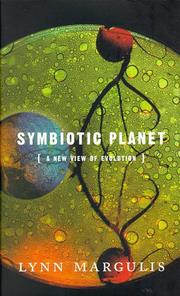Check nearby libraries
Buy this book

Although Charles Darwin's theory of evolution laid the foundations of modern biology, it did not tell the whole story. Most remarkably, The Origin of Species said very little about, of all things, the origins of species. Darwin and his modern successors have shown very convincingly how inherited variations are naturally selected, but they leave unanswered how variant organisms come to be in the first place.
In Symbiotic Planet, renowned scientist Lynn Margulis shows that symbiosis, which simply means members of different species living in physical contact with each other, is crucial to the origins of evolutionary novelty. Ranging from bacteria, the smallest kinds of life, to the largest - the living Earth itself - Margulis explains the symbiotic origins of many of evolution's most important innovations.
Along the way, Margulis describes her initiation into the world of science and the early steps in the present revolution in evolutionary biology; the importance of species classification for how we think about the living world; and the way "academic apartheid" can block scientific advancement.
Check nearby libraries
Buy this book

Previews available in: English
| Edition | Availability |
|---|---|
|
1
Symbiotic Planet : A New Look at Evolution (Science Masters Series)
March 2000, Basic Books
in English
0465072720 9780465072729
|
eeee
|
|
2
Symbiotic planet: a new look at evolution
1998, Basic Books
in English
- 1st ed.
0465072712 9780465072712
|
aaaa
|
|
3
The symbiotic planet: a new look at evolution.
1996, Weidenfeld & Nicolson, Orion Publishing Group, Limited
in English
029781740X 9780297817406
|
zzzz
|
Book Details
Edition Notes
Includes bibliographical references (p. 131-136) and index.
Classifications
The Physical Object
ID Numbers
Source records
Scriblio MARC recordLibrary of Congress MARC record
Library of Congress MARC record
Internet Archive item record
marc_openlibraries_sanfranciscopubliclibrary MARC record
marc_claremont_school_theology MARC record
Library of Congress MARC record
marc_claremont_school_theology MARC record
marc_nuls MARC record
marc_columbia MARC record
First Sentence
"Symbiosis, the system in which members of different species live in physical contact, strikes us as an arcane concept and a specialized biological term."
Work Description
Although Charles Darwin's theory of evolution laid the foundations of modern biology, it did not tell the whole story. Most remarkably, <I>The Origin of Species
Community Reviews (0)
Feedback?| June 17, 2023 | Edited by ImportBot | import existing book |
| January 9, 2023 | Edited by HopeEvey | Copied description from The Storygraph |
| July 27, 2020 | Edited by MARC Bot | import existing book |
| February 14, 2020 | Edited by MARC Bot | remove fake subjects |
| December 9, 2009 | Created by WorkBot | add works page |











